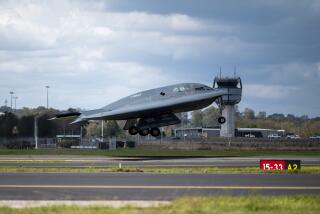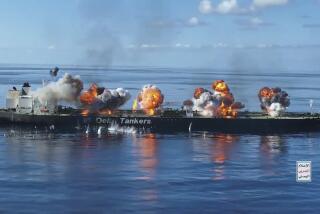Skilled Terrorists, Financing Believed Behind Ship Blast
WASHINGTON — U.S. officials said Friday that evidence increasingly suggests a highly sophisticated terrorist operation caused the powerful blast that killed as many as 17 American sailors in Yemen and crippled one of the Navy’s most advanced combat ships.
With dozens of additional FBI, Pentagon and other anti-terrorism investigators due to arrive today in the Yemeni port of Aden, U.S. law enforcement and intelligence agencies launched a worldwide search for likely sponsors and accomplices of the apparent suicide bombers.
Although no suspects have been ruled out, officials said they doubt that the apparent bombing of the $1-billion guided missile destroyer Cole was the work of Yemeni militants or a handful of freelance extremists. It is far more likely, they said, that the attack was carefully planned and carried out by a large, well-financed organization, and perhaps even a hostile government.
The search for perpetrators ensued as Pentagon officials increased the official U.S. death count to seven sailors, up from six on Thursday, and predicted that the toll would rise to 17 after investigators complete a gruesome search for missing crew members.
The Pentagon released the names of the dead and missing crew members. The victims include two women, apparently the first ever killed in an attack on a Navy ship. One was from San Diego.
The Defense Department said it would launch a comprehensive review of the security procedures followed by the Cole during its stop in Yemen. The study will encompass the use of local contractors to assist with refueling and other ship services.
Officially, State Department and White House spokesmen continued to refer to Thursday’s explosion as an “apparent act of terrorism,” citing a lack of conclusive evidence.
But investigators are working under the assumption that it was caused by terrorists who successfully infiltrated harbor operations in Aden to gather crucial intelligence on the approaching U.S. warship, to smuggle crates of high explosives onto a port service boat and to join a work crew that was hauling mooring lines from the destroyer as it prepared for refueling.
The explosion rocked the Cole after two men motored alongside in a 20-foot wooden tender, a vessel large enough to carry several thousand pounds of explosives. The blast ripped a gaping hole--about 30 feet high and 40 feet wide--amidships on the gray steel hull.
“This wasn’t just two guys with a dream,” said a U.S. counter-terrorism expert who asked not to be identified. “This was carefully planned. You need people with explosives expertise, with logistics expertise, who know how to put together a cell, know how to do surveillance. . . . This isn’t the work of a bunch of amateurs.”
The United States has spent more than $1.5 billion to upgrade security at U.S. diplomatic facilities overseas since the August 1998 terrorist bombings of American embassies in Kenya and Tanzania, which killed more than 220 people. The apparent attack on a 4-year-old warship, sheathed with half-inch armor and bristling with the latest high-tech weaponry and radar, suggests a deliberate attempt to humiliate those efforts.
“What makes me think this is a professional terrorist attack is it’s so audacious,” said Rep. Porter J. Goss (R-Fla.), chairman of the House Select Committee on Intelligence. Taking out a sophisticated U.S. warship “gives them real bragging rights.”
Mansoor Ijaz, a counter-terrorism expert in New York, concurred that the choice of target seems to suggest an ambitious agenda. “They have shown they can still strike us where it hurts,” he said.
So far, only a small, Aden-based militant group has claimed responsibility. But a U.S. intelligence official warned that the group, believed to be an offshoot of the Islamic Army of Aden, has never displayed the kind of intricate infrastructure, planning and logistics required for the apparent attack on the Cole.
“Something like this is much more complicated than anything they’ve done before,” the official said. “And people have been known to claim responsibility on their behalf before for things we know they didn’t do. No one is ruling anything out yet, but I’d take their claim with a grain of salt.”
One working theory, so far without proof, is that Iraq’s intelligence service helped with the planning and logistics required for an attack. Iraqi President Saddam Hussein has intensified his threats against the United States, Israel and Arab states such as Kuwait and Saudi Arabia in recent weeks, and the Cole was en route to a six-month deployment in the Persian Gulf to help enforce the U.S. and U.N. embargo against the Baghdad regime.
Although President Clinton has vowed to hold accountable those responsible for the apparent attack on the Cole, other officials warned that the perpetrators might never be found. “We’re going to have a very difficult time identifying and bringing these people to justice,” Goss said.
Indeed, those who orchestrate major terrorist attacks are rarely identified with clear certainty, and even more rarely captured or prosecuted.
The June 1996 truck bombing of a military barracks in Dhahran, Saudi Arabia, which killed 19 U.S. airmen, is a case in point. More than four years later, U.S. authorities have yet to firmly identify those responsible for the Khobar Towers attack, and the probe has effectively collapsed because of disputes with Saudi investigators.
Similarly, no one was ever arrested or convicted for the April 1983 bombing of the U.S. Embassy in Beirut, which killed 63 people, including at least 16 Americans. Nor was anyone arrested or convicted for the bombing in October 1983 of the U.S. Marine barracks in Beirut, which killed 241 Americans.
The United States has indicted fugitive Saudi militant Osama bin Laden and 16 others for their alleged role in the August 1998 bombings of two U.S. embassies in East Africa. Six defendants are awaiting trial in New York. One is in custody in Britain and two are in jail in Tanzania; they are awaiting extradition to the United States. Eight are fugitives, including Bin Laden.
U.S. officials say Bin Laden operates from Afghanistan, a sanctuary that allows him to secretly finance and supply militant Muslim followers around the world. At least two of the eight terrorist groups known to operate in Yemen are avowed adherents of Bin Laden’s anti-U.S. ideology.
As a result, Bin Laden “is certainly high on everyone’s list” for the attack on the Cole, said Kenneth Katzman, a counter-terrorism expert at the Congressional Research Service. “It certainly fits with his agenda.”
*
Times staff writer Paul Richter contributed to this report.
* PRAYERS AND TEARS
Loved ones mourn the dead and cling to hope for sailors still missing. A16
* DEATH TOLL LIKELY 17
Officials predict the death toll in the apparent bombing of the Cole would rise to 17. A17
(BEGIN TEXT OF INFOBOX / INFOGRAPHIC)
Bombing Victims
These are the seven sailors killed aboard the Cole on Thursday. Ten others are missing and presum-ed dead. They will not be listed as killed until their remains are found and identified.
*
Richard Costelow
Morrisville, Pa.
*
Cherone Louis Gunn
Rex, Ga.
*
James Rodrick McDaniels
Norfolk, Va.
*
Lakiba Nicole Palmer
San Diego
*
Timothy Lamont Saunders
Ringgold, Va.
*
Andrew Triplett
Macon, Miss.
*
Craig Wibberly
Williamsport, Md.
Radical Groups in Yemen
Although the president of Yemen denies the existence of terrorist groups in his country, the U.S. State Department has identified several radical Islamic organizations operating there. Here’s a look at some of the groups:
Hamas
* Origin: Islamist Palestinian organization formed by Muslim Brotherhood activists at the start of the 1987-93 Palestinian uprising (intifada).
* Strength: Unknown number of hard-core members, tens of thousands of supporters and sympathizers.
Islamic Jihad
* Origin: Formed in 1979, remains mostly a guerrilla organization headquartered in Syria, with some presence in Jordan.
* Strength: Unknown. U.S. officials say the group is politically closer to Iran than is Hamas.
* U.S. targets: Neither Hamas nor the Islamic Jihad have targeted the U.S. directly, but Americans have died in attacks by both groups.
* Funding: Both groups receive funds (several million dollars per year) and possibly military training from Iran.
Radical Islamic movement
* In 1998, a group calling itself the Army of Aden-Abyan kidnapped 16 tourists, and four were killed during the rescue attempt. According to a 1999 State Department report, the group advocates imposing Islamic law in Yemen and lifting international sanctions against Iraq, and opposes the use of Yemeni ports and bases by U.S. and other Western countries.
Osama bin Laden network
* Origin: Osama bin Laden, the exiled Saudi Arabian whom U.S. officials blame for the bombings of American embassies in Kenya and Tanzania in 1998, founded Al Qaida (“the military base”) in 1990.
* Strength: Bin Laden is estimated to have about $300 million in personal assets and a network of as many as 3,000 Islamic militants. Al Qaida cells have been identified or suspected in many Middle Eastern countries, including Yemen.
Sources: U.S. State Department’s 1999 report on Global Terrorism; Congressional Research Service’s report, “Terrorism: Middle Eastern Groups and State Sponsors, 1999”
More to Read
Sign up for Essential California
The most important California stories and recommendations in your inbox every morning.
You may occasionally receive promotional content from the Los Angeles Times.











